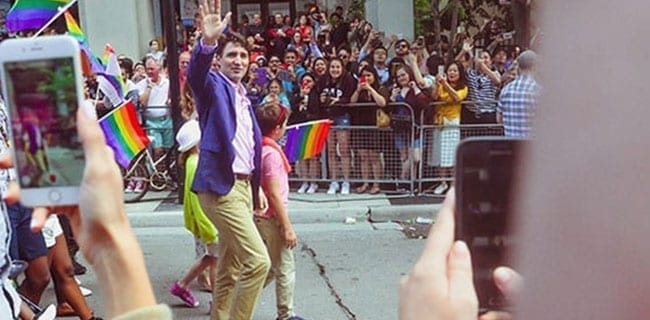As Trudeau campaigns for re-election, his body language will play a crucial role in shaping his public image
 As the upcoming federal elections loom, political leaders are in the spotlight more than ever. Prime Minister Justin Trudeau, Conservative Leader Pierre Poilievre, and NDP Leader Jagmeet Singh are all vying for the public’s attention. We watch their speeches, listen to their promises, and dissect their policies. But beyond the words and political rhetoric, there’s another layer of communication that’s equally powerful – body language.
As the upcoming federal elections loom, political leaders are in the spotlight more than ever. Prime Minister Justin Trudeau, Conservative Leader Pierre Poilievre, and NDP Leader Jagmeet Singh are all vying for the public’s attention. We watch their speeches, listen to their promises, and dissect their policies. But beyond the words and political rhetoric, there’s another layer of communication that’s equally powerful – body language.
Body language isn’t just a series of random movements; it’s a window into a leader’s true emotions, intentions, and leadership style. It can tell us whether they are genuinely confident, empathetic, or just putting on a show. As voters, understanding these non-verbal cues can help us make more informed decisions about who we want to lead our country.
In this series, we’ll dive into the body language of some of the key players in Canadian federal politics. From Trudeau’s open and engaging gestures to Poilievre’s assertive and precise movements, we’ll decode what their body language says about them as leaders. We’ll also look at Singh’s charismatic and approachable style.
Why focus on body language, you ask?
Because it’s often the unspoken elements that reveal the most: a handshake can tell you about a person’s confidence and sincerity; eye contact can convey honesty or deception; how a leader stands or moves can reflect their readiness to lead or their underlying insecurities.
As a communication specialist, I’m here to help you see beyond the speeches and sound bites, but I have no intention of influencing or swaying you towards any of the candidates. I trust you can draw your own conclusions simply by watching for these tell-tale signs as the election campaigns get underway. Once the campaigns heat up, we will come back and discuss body language cues and what may have changed for each candidate.
I hope you will draw additional conclusions based on the non-verbal gestures, not just the well-rehearsed and choreographed narratives. By understanding these subtle signals, you’ll gain a deeper insight into the candidates vying for the top spots in federal politics. This knowledge will not only make you a more informed voter but also a keen observer of human behaviour.
So, rather than relying on social media memes for insight and decision-making, let’s take some objectivity from the body language lens and make up our minds with both speeches and delivery aspects in mind.
Whether you’re a seasoned political enthusiast or a casual observer, these insights may give you a new perspective on the upcoming elections. After all, in politics, what’s unsaid is often just as important as what’s said.
First up is Justin Trudeau.
 |
| Related Stories |
| Was Trudeau’s promise of “sunny ways” always a con?
|
| Why Trudeau’s reign as Dear Leader is coming to an end
|
| Justin, stop whining and just go already
|
Decoding Justin Trudeau
As Prime Minister Justin Trudeau gears up for the upcoming elections, his body language is under intense scrutiny. Trudeau’s gestures, expressions, and movements are integral to his communication style, revealing much about his leadership and how he connects with voters. Let’s break down some of his key body language signals, particularly how he handles public scrutiny and his defensiveness, and explore their implications as he campaigns for re-election.
Open Hand Gestures
Trudeau is known for his frequent use of open hand gestures. When addressing the public or during parliamentary sessions, his open palms facing upwards or outwards convey openness, honesty, and a willingness to engage.
Implication: These gestures reinforce his image as a transparent and approachable leader, crucial for maintaining public trust during election season. However, in times of public scrutiny, these gestures can sometimes appear rehearsed if not backed by consistent behavior.
The Double-Handed Shake
The double-handed handshake is a signature move for Trudeau. This gesture, where he uses both hands to clasp the hand of the person he’s greeting, is often seen in contexts where he seeks to convey warmth and sincerity.
Implication: The double-handed shake enhances perceptions of Trudeau’s empathy and genuine interest in others, strengthening his relational connections both domestically and internationally. However, they can also be seen as a desire to control all exchanges.
Smiles and Eye Contact
Trudeau’s engaging smile and direct eye contact are central to his public interactions. A genuine smile, characterized by crinkling around the eyes (Duchenne smile), indicates positive emotions and approachability. Consistent eye contact signals confidence and attentiveness.
Implication: Trudeau’s frequent use of genuine smiles and sustained eye contact helps create a positive and engaging atmosphere, making him appear confident, likable, and connected with his audience.
Furrowed Brow and Head Tilt
In moments of serious discussion or when addressing critical issues, Trudeau’s facial expressions shift. A furrowed brow and a slight head tilt often accompany his serious or contemplative statements.
Implication: By displaying these expressions, Trudeau communicates his attentiveness to serious matters, conveying that he is thoughtful and emotionally engaged with the issues.
Defensive Body Language
When faced with criticism or tough questions, Trudeau exhibits defensive body language, such as crossed arms, tightened lips, or a more rigid posture. These signals can indicate discomfort and telegraph a desire to protect oneself.
Implication: Defensive body language may create a perception of vulnerability or unwillingness to engage openly with critics. This can be a double-edged sword during an election campaign, potentially undermining his image as a transparent and approachable leader.
Public Scrutiny and Adaptability
Trudeau’s ability to adapt his body language under scrutiny is key. He consciously shifts from defensive postures to more open and engaging gestures, demonstrating resilience and a willingness to connect despite the pressure.
Implication: His adaptability can help mitigate negative perceptions, showing voters he can handle tough situations with grace. However, consistently maintaining this adaptability is crucial for preserving trust and confidence among voters. As a voter, you will need to decide for yourself how sincere you feel he is.
Upright Posture
Trudeau’s upright posture is a critical element of his commanding presence. Whether delivering a speech or engaging in dialogue, his posture remains erect, signalling confidence, authority, and readiness.
Implication: An upright posture reinforces the image of a leader who is in control, self-assured, and prepared to tackle challenges, which is essential in establishing authority and respect.
Controlled Gestures
Trudeau’s gestures are typically measured and controlled, avoiding overly dramatic or erratic movements. This control demonstrates composure and deliberation, suggesting that he carefully considers his actions and words.
Implication: Controlled gestures help influence a calm and collected image, reducing the risk of being perceived as impulsive or reactive. This trait is essential in high-stress situations or during diplomatic engagements.
Respecting Personal Space
Proxemics, or the use of personal space, is another critical aspect of body language. Trudeau generally respects personal space, maintaining an appropriate distance during interactions. This respect for boundaries is particularly evident in his interactions with diverse cultural groups where personal space preferences may vary.
Implication: By respecting personal space, Trudeau demonstrates cultural sensitivity and respect for individual boundaries, which may enhance his diplomatic and interpersonal effectiveness.
Strategic Proximity
However, Trudeau also knows when to bridge the gap, moving closer to individuals in moments requiring empathy or solidarity, such as comforting a grieving person or expressing support to a colleague.
Implication: Strategic proximity can strengthen emotional connections and convey solidarity, making Trudeau appear more compassionate and supportive.
Conclusion
As Trudeau campaigns for re-election, his body language will play a crucial role in shaping his public image. His gestures, facial expressions, posture, and use of personal space all combine to present him as an open, empathetic, and authoritative leader. However, his defensive body language, when under scrutiny, can undermine this image if not managed carefully.
The upcoming elections will test Trudeau’s ability to maintain a balance between openness and defensiveness. His adaptability in handling public scrutiny will be critical in determining whether voters continue to see him as a trustworthy and resilient leader. So, as we watch him navigate the campaign trail, let’s pay close attention to those subtle signals – they’re not just about politics but about connection, trust, and leadership in the highest office.
Tomorrow I will decode Pierre Poilievre.
Faith Wood is a professional speaker, author, and certified professional behaviour analyst. Prior to her speaking and writing career, she served in law enforcement, which gives her a unique perspective on human behaviour and motivations. Faith is also known for her work as a novelist, with a focus on thrillers and suspense. Her background in law enforcement and understanding of human behaviour often play a significant role in her writing.
For interview requests, click here.
The opinions expressed by our columnists and contributors are theirs alone and do not inherently or expressly reflect the views of our publication.
© Troy Media
Troy Media is an editorial content provider to media outlets and its own hosted community news outlets across Canada.
